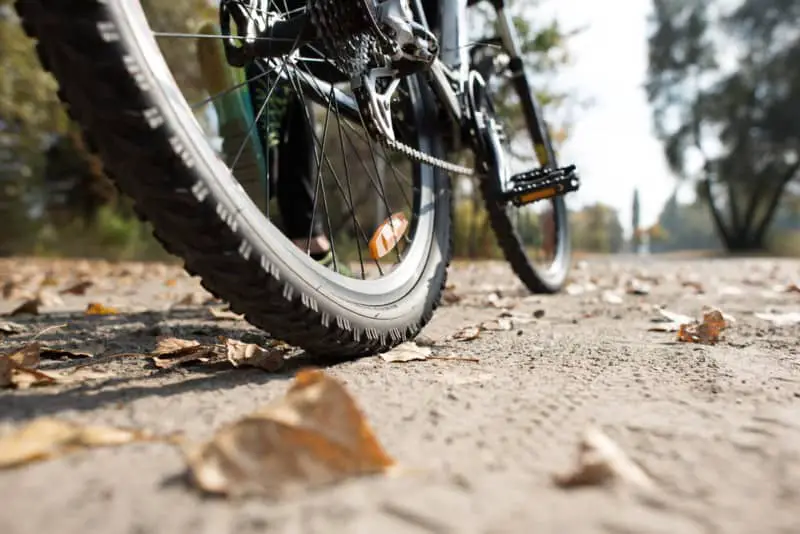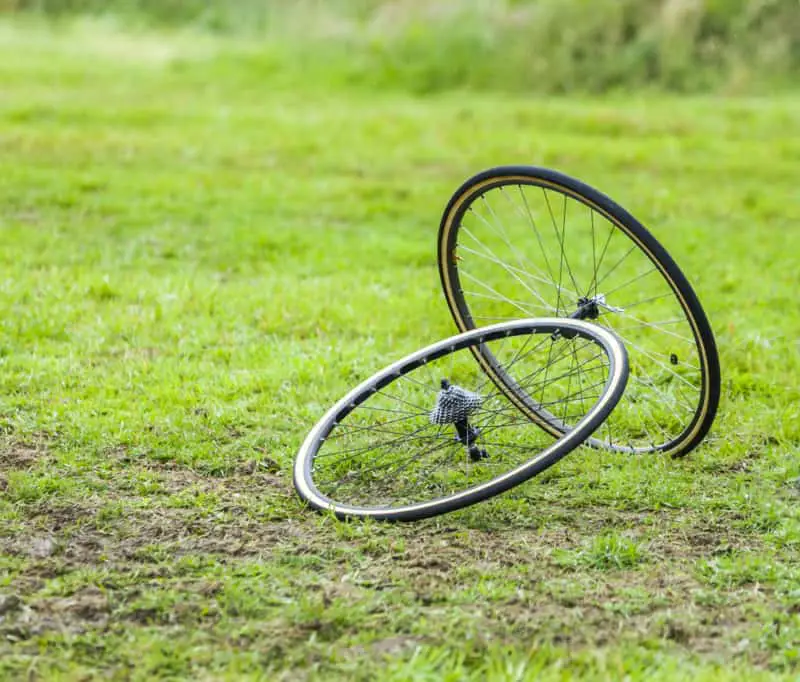It’s not often you’ll run into a situation where both of your bike tires puncture or wear out at the same time. Should you replace both tires anyway so they match, or can you just change one?
It’s perfectly fine if your bike tires don’t match. In fact, many riders choose different tire brands, widths, tread designs and casings for their front and rear tires. Your bike’s front and rear wheels handle differently and perform unique functions, so different tires may be required to meet those specific needs.
Let’s take a look at how each individual factor impacts your tire’s performance, and what you should look for in a front vs. rear tire.
Should Both Bike Tires Match? (Consider These Factors)

1. Brand
It’s very common to choose a front and rear tire from the same brand. Most riders have a brand they prefer, and as each company makes a variety of tires designed for different purposes, there isn’t a huge benefit to seeking out different brands for front and rear tires.
However, running tires from two different brands will not have any negative consequences. For instance, my front tire is a Maxxis and my rear tire is a Continental, and I haven’t noticed any performance issues.
If you’ve done your research and there’s a particular tire you want to try out, but it’s not the same brand as your other tire, go for it! Mixing and matching is the best way to find out which tires best fit your riding style.
2. Width
Tire width is an important consideration when it comes to how your bike handles. A wide tire will offer better grip, traction and braking ability, while a narrow tire will roll faster.
Usually, new bikes will come stock with either two identical width tires or a front tire wider than the rear.
The latter is more common: since the front wheel handles most of the grip and braking forces, a wider tire will provide better traction and brake control. A rear tire has most of your body weight over it, so traction isn’t as big an issue. That’s why a narrower, faster rolling tire is preferred.
I use a 2.5 inch front tire and a 2.4 inch rear tire on my mountain bike, which I find to be very effective.
So is there ever a reason (or any benefit) to riding with a narrow front tire and wide rear tire? Not really. Based on their respective functions, you’d be placing both wheels at a disadvantage by running this configuration.
3. Tread
A tire’s tread pattern makes a big difference in how that tire performs. There are different tread patterns designed to suit different riding styles and types of terrain or weather conditions, so your choice of tire tread should be based on these factors primarily.
Some tires are designed specifically to work as a front tire or rear tire. A front tire will feature larger center lugs and side knobs to really dig into the corners and keep you from sliding out. A rear tire will feature shorter knobs, which decreases rolling resistance and helps you accelerate faster (since bikes are rear-wheel drive).
Even if they have a specific designation, some tires work just fine on the front or rear, such as the Maxxis Minion DHR (which many companies spec on their bikes’ front and rear wheels right from the factory).
4. Rubber Compound
Most companies offer tires in different rubber compounds. Softer compounds provide better grip (they literally “stick” to the road or trail) but wear out faster, while harder compounds last longer and roll faster, but don’t grip as well.
A softer compound is great on a front tire, because this tire is all about traction. You can get away with a harder compound for the rear tire: it won’t provide as much grip, but the added body weight over the tire can reduce this effect.
Softer compounds provide benefits for both tires, but they will be more expensive: for example, the top-tier BlackChili compound from Continental will set you back about $20-30 more per tire than the same model with the standard compound.
It’s well worth it if you can justify the price (and don’t forget, you’ll be replacing them more often), but if you can only afford one, get a softer compound for your front tire.
5. Casing
Most tires are offered in a few casing options. Tire casings are designed to complement different riding disciplines and rider weights.
If you’re a lighter, less aggressive rider, you can choose a lighter casing. This saves a measurable amount of weight. For a heavier, more aggressive rider, this casing just won’t be durable enough to withstand the additional strain placed on it, so you’ll need a heavier casing.
As an example, Maxxis offers four casing options (from lightest to most durable): EXO, EXO+, DoubleDown, and Downhill.
Generally you can use the same casing on your front and rear tire, but if you’re a heavier or more aggressive rider who values saving weight, at least get a more durable casing for your rear tire (since this wheel takes more abuse).
6. Diameter
Now for the most controversial of factors. For the vast majority of bikes, you’ll want to choose the same diameter tire both front and rear.
However…
You may have heard of “mullet” bikes. Just like the popular hairstyle, these bikes are business in the front with a 29er wheel that rolls over just about anything, and party in the back with a 27.5 that keeps things agile and fun.
The jury’s out on whether these bikes truly offer the advantages of both wheel sizes with none of the drawbacks…but personally I can’t wait to try one and find out for myself!
The question often arises: “can you mullet any bike?” And the answer is no, not without a lot of alterations to the bike’s geometry at least. So before you go buying a larger front or smaller rear wheel to convert your own bike, do your research first on whether it’s even possible…or safe.
Can You Replace Just One Bike Tire?

If one tire wears out, there’s no need to replace both if the other one still has a good amount of tread left and appears undamaged. Tires are expensive, so I recommend using them until you absolutely have to replace them.
Now if your rear tire wears out and your front tire is looking a little ragged too, you do have another option. If the tires are compatible, many riders will scrap the damaged rear tire, replace it with the current front tire, and then buy a new front tire instead.
Why would you want to do this? Well the front tire handles most of the braking duties and plays a far bigger role in maintaining traction. A fresh new front tire will improve performance in these categories, but your old front tire can still do quite well on the rear, where grip isn’t as much of an issue (remember: more weight over the tire means more grip).
No need to scrap something that still has some life in it!
Is There a Difference Between Front / Rear Tires?
Front and rear tires are designed for different purposes. Front tires are responsible for maintaining grip and helping you slow down faster, so they’re usually wider and feature larger lugs and side knobs which dig into whatever surface you ride on. Rear tires are made to roll faster; narrow tires with lower-profile lugs reduce drag and maintain speed better.
Just because a tire is designated front or rear, doesn’t mean that’s where it has to go! If you prefer your bike to have as much grip as possible, then two front-oriented tires might be for you. If you want a playful bike for doing tricks and just having fun at a bike park, two rear tires might be a better option.
You can use a tire’s characteristics to suit your individual riding style. Don’t be afraid to experiment and try out different combinations.
Impact of Having Different Front / Rear Tires
Ask 100 riders, and it’s likely few of them will have matching front and rear tires. Tire choice is a very individual thing: width, tread pattern, rubber compound and casing all significantly impact your bike’s handling and overall feel…as does tire diameter for you mullet bike riders!
Since most new and used bikes on the market today come equipped with mismatched tires, there’s obviously some benefit to doing this.
Choosing front and rear tires with the characteristics that suit your individual needs will vastly improve ride quality, performance, and enjoyment. So when it’s time to replace one or both of your tires, seriously analyze your riding style and the terrain you spend the most time on, and then choose tires best suited to those factors.
